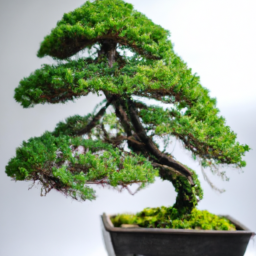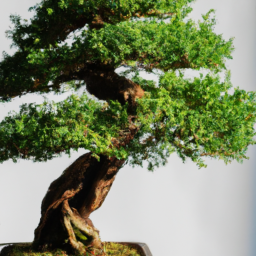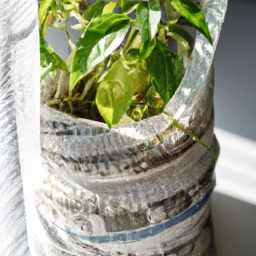
Have you ever marveled at the beauty and tranquility of a bonsai tree? The art of creating a bonsai indoor garden is a fascinating practice that allows you to bring the serenity of nature into your own home. Whether you are a seasoned gardener or a beginner with a green thumb, this ancient Japanese art form offers a unique and rewarding experience. In this blog post, we will explore the art of creating a bonsai indoor garden, from selecting the right tree to nurturing it with care. So, grab a cup of tea, sit back, and let’s embark on this journey of cultivating miniature masterpieces.
Choosing the Right Bonsai Species for Indoor Gardening
Introduction
Welcome to the world of bonsai indoor gardening! Creating a bonsai indoor garden can be a rewarding and fulfilling experience. It allows you to bring the beauty and tranquility of nature right into your home. One of the most crucial steps in this art form is choosing the right bonsai species for indoor gardening. In this guide, we will walk you through the process of selecting the perfect bonsai species that will thrive and flourish in your indoor environment.
Understanding Indoor vs. Outdoor Bonsai
Before delving into the specifics of choosing a bonsai species for indoor gardening, it is important to understand the fundamental differences between indoor and outdoor bonsai. Outdoor bonsai are typically more robust and can withstand the natural elements like sunlight, wind, and rain. On the other hand, indoor bonsai require a more controlled environment as they are shielded from these natural conditions. Therefore, it is essential to choose a species that can adapt and thrive in an indoor setting.
When selecting a bonsai species for indoor gardening, consider the following factors:
Light Requirements
Light is a crucial element for the growth and development of any plant, including bonsai. Different bonsai species have varying light requirements. Some species thrive in bright, direct sunlight, while others prefer partial shade. Assess the available light conditions in your indoor space and choose a bonsai species that can adapt to those conditions. If you have limited natural light, consider supplementing with artificial grow lights to ensure your bonsai receives adequate light for healthy growth.
Here are a few bonsai species suitable for different light conditions:
High Light Conditions
Bonsai species that thrive in high light conditions include:
- Ficus Bonsai
- Juniper Bonsai
- Chinese Elm Bonsai
Medium Light Conditions
Bonsai species that can tolerate medium light conditions include:
- Japanese Maple Bonsai
- Schefflera Bonsai
- Portulacaria Afra (Dwarf Jade) Bonsai
Low Light Conditions
Bonsai species that can thrive in low light conditions include:
- Zenobia Bonsai
- Sansevieria Bonsai
- Podocarpus Bonsai
Climate and Temperature
Indoor environments tend to have more stable temperatures compared to the fluctuating outdoor conditions. However, it is still crucial to select a bonsai species that can tolerate the climate and temperature of your indoor space. Some bonsai species prefer cooler temperatures, while others thrive in warmer conditions. Consider the average temperature range in your home and choose a species that can thrive in that specific climate.
Here are a few bonsai species suitable for different temperature ranges:
Cooler Temperatures
Bonsai species that prefer cooler temperatures include:
- Japanese Maple Bonsai
- Satsuki Azalea Bonsai
- Crabapple Bonsai
Warmer Temperatures
Bonsai species that thrive in warmer temperatures include:
- Ficus Bonsai
- Chinese Elm Bonsai
- Bougainvillea Bonsai
Size and Space
Consider the available space in your indoor environment when selecting a bonsai species. Some species naturally grow larger and require more space, while others remain compact and are better suited for smaller areas. It is important to choose a bonsai species that can comfortably fit and grow within the space you have allocated for your indoor garden. Remember, regular pruning and shaping will also play a role in controlling the size of your bonsai.
Here are a few bonsai species suitable for different space requirements:
Compact Species
Bonsai species that remain compact include:
- Boxwood Bonsai
- Japanese Black Pine Bonsai
- Shimpaku Juniper Bonsai
Larger Species
Bonsai species that naturally grow larger include:
- Bald Cypress Bonsai
- Olive Bonsai
- Japanese Maple Bonsai
Conclusion
Choosing the right bonsai species for indoor gardening is a crucial step in creating a thriving and visually appealing indoor garden. Consider the light requirements, climate and temperature, as well as the size and space available in your indoor environment. By selecting a bonsai species that can adapt and flourish in these conditions, you are setting yourself up for success in the art of creating a bonsai indoor garden. Happy gardening!

The Art of Creating a Bonsai Indoor Garden
2. Essential Tools and Techniques for Creating a Bonsai Indoor Garden
In the art of bonsai, creating an indoor garden requires a careful selection of tools and techniques to ensure the health and beauty of your miniature trees. In this guide, we will explore the essential tools and techniques that every bonsai enthusiast should be familiar with. Whether you are a beginner or an experienced gardener, these tips will help you create a stunning bonsai indoor garden.
Choosing the Right Tools
When it comes to bonsai gardening, having the right tools is crucial. Here are some essential tools you will need:
1. Pruning Shears: Pruning shears are essential for trimming the branches and leaves of your bonsai trees. Choose a pair with a sharp blade and a comfortable grip to ensure precise cuts.
2. Root Pruning Shears: Root pruning shears are specially designed to trim the roots of your bonsai trees. These shears have a sharp, curved blade that allows you to remove excess roots without damaging the tree.
3. Bonsai Wire: Bonsai wire is used to shape the branches and trunk of your bonsai trees. It is available in different sizes and materials, such as aluminum or copper. Choose a wire that is strong enough to hold the desired shape but flexible enough to avoid damaging the tree.
4. Bonsai Soil: Bonsai soil is a well-draining soil mix that provides the necessary nutrients and moisture for your bonsai trees. It is usually a blend of akadama, pumice, and lava rock. Avoid using regular potting soil, as it can retain too much water and cause root rot.
5. Watering Can: A watering can with a fine nozzle is ideal for watering your bonsai trees. It allows you to control the water flow and prevent overwatering.
Techniques for Creating a Bonsai Indoor Garden
Creating a bonsai indoor garden requires a combination of techniques to shape and maintain your trees. Here are some essential techniques to master:
1. Pruning: Pruning is the process of selectively removing branches and leaves to shape your bonsai tree. Regular pruning helps maintain the desired size and form of your tree. Use pruning shears to make clean cuts just above a leaf node or bud.
2. Wiring: Wiring is a technique used to shape the branches and trunk of your bonsai tree. Start by wrapping bonsai wire around the branch or trunk, making sure to protect the bark with a layer of raffia or tape. Gently bend the wire to the desired shape, taking care not to apply too much pressure that could cause damage.
3. Repotting: Repotting is necessary to provide fresh soil and prevent root-bound trees. Repot your bonsai every one to two years, depending on its growth rate. Carefully remove the tree from its pot, trim the roots, and replant it in fresh bonsai soil. Water thoroughly after repotting to help the tree recover.
4. Watering: Proper watering is crucial for the health of your bonsai trees. Check the moisture level of the soil regularly by inserting a finger about an inch deep. If the soil feels dry, water the tree thoroughly until the water drains out of the drainage holes. Avoid overwatering, as it can lead to root rot.
5. Fertilizing: Bonsai trees require regular fertilization to provide the necessary nutrients for growth. Use a balanced bonsai fertilizer or a slow-release fertilizer specifically formulated for bonsai. Follow the instructions on the fertilizer package and adjust the frequency based on the needs of your tree.
By mastering these essential tools and techniques, you will be well on your way to creating a beautiful bonsai indoor garden. Remember to practice patience and enjoy the process of nurturing and shaping your miniature trees. Happy gardening!

Maintaining and Caring for Your Bonsai Indoor Garden
Introduction
Welcome to the world of bonsai! Creating and nurturing a bonsai indoor garden is a rewarding and artistic endeavor. Once you have carefully crafted your bonsai, it is essential to understand how to maintain and care for it properly. In this guide, we will explore the key steps and techniques to ensure the health and longevity of your bonsai masterpiece.
1. Watering
Watering is perhaps the most critical aspect of bonsai care. The frequency and amount of water required depend on various factors such as the species of your bonsai, the size of the pot, and the environmental conditions. It is crucial to strike a balance between underwatering and overwatering, as both can harm your bonsai.
First, check the moisture level of the soil by gently inserting your finger about an inch deep. If the soil feels dry, it is time to water your bonsai. Use a watering can or a soft spray nozzle to water the soil evenly until you see water draining out from the drainage holes. Avoid leaving your bonsai sitting in a tray filled with water, as this can lead to root rot.
During hot summer months, you may need to water your bonsai more frequently. Conversely, in the winter, when the growth slows down, you should reduce the watering frequency. Remember, each bonsai has its unique watering requirements, so observe your tree closely and adjust accordingly.
2. Pruning and Shaping
Pruning and shaping are essential techniques to maintain the desired form and size of your bonsai indoor garden. Regular pruning helps control the growth and encourages the development of fine branches and foliage. It also allows you to create a visually appealing silhouette and maintain the overall balance of your bonsai.
Start by removing any dead, damaged, or diseased branches. Use sharp and clean bonsai pruning shears or scissors to make precise cuts at a slight angle just above a leaf node or bud. Avoid leaving stubs, as they can hinder the healing process. Additionally, thin out dense areas by selectively removing excess branches to improve airflow and light penetration.
Shaping your bonsai involves wiring the branches to achieve the desired position and movement. Carefully wrap bonsai wire around the branches, taking care not to damage the bark. Gently bend the branches into the desired shape, ensuring they maintain a natural appearance. Leave the wire in place for a few months, but regularly check for any signs of wire cutting into the bark and remove it promptly if necessary.
3. Fertilizing
Fertilizing provides the necessary nutrients for your bonsai to thrive and maintain its health. Bonsai trees are planted in small pots with limited soil, which depletes nutrients more quickly than in the wild. Therefore, regular fertilization is crucial to replenish these nutrients and promote healthy growth.
Choose a balanced, slow-release bonsai fertilizer or a liquid fertilizer specifically formulated for bonsai. Follow the instructions on the packaging to determine the appropriate dosage and frequency. Generally, fertilizing once every two to four weeks during the growing season (spring to autumn) is recommended.
Apply the fertilizer evenly across the surface of the soil, avoiding direct contact with the trunk or foliage. Water your bonsai immediately after fertilizing to ensure proper absorption. Remember, overfertilization can lead to root burn or excessive growth, so it is crucial to follow the recommended dosage.
Conclusion
Maintaining and caring for your bonsai indoor garden is an ongoing process that requires patience, observation, and a deep understanding of your tree’s needs. By mastering the art of watering, pruning, shaping, and fertilizing, you can ensure the health and vitality of your bonsai masterpiece for years to come. Remember, each bonsai is unique, and it is essential to adapt your care routine to suit its specific requirements. Enjoy the journey of tending to your bonsai and witnessing its beauty flourish!
I’ll leave you with these final thoughts
Creating a bonsai indoor garden is a delightful way to bring nature’s beauty into your home. It allows you to cultivate miniature trees that exude elegance and serenity, while also adding a touch of tranquility to your living space. If you’re a plant lover or simply looking for a new hobby, the art of bonsai is worth exploring.
To start your bonsai indoor garden, begin by selecting the right tree species. Consider factors like the amount of sunlight your home receives, the humidity levels, and the space available for your bonsai. Once you’ve chosen a suitable tree, it’s time to get your hands dirty. Begin by carefully pruning the branches and roots to shape the tree into your desired style. Remember, bonsai is an art form that requires patience and attention to detail. After pruning, repot the tree using a well-draining soil mix, and make sure to water it regularly to maintain the right moisture levels. Additionally, it’s important to provide the necessary nutrients through fertilization, as bonsai trees are grown in small containers and rely on us for their sustenance. Finally, don’t forget to regularly trim and wire the branches to maintain the desired shape and form of your bonsai. With time and dedication, your indoor bonsai garden will flourish, becoming a stunning centerpiece that brings a sense of peace and beauty to your home.
Top FAQs:
Q1: What is a bonsai indoor garden?
A1: A bonsai indoor garden is a miniature garden created with carefully pruned and trained trees, typically kept indoors. It is a form of art that involves cultivating and nurturing small trees in containers, replicating the shape and scale of full-sized trees found in nature.
Q2: How do I start creating a bonsai indoor garden?
A2: To begin creating a bonsai indoor garden, you’ll need to select a suitable tree species that can thrive indoors, such as ficus, jade, or juniper. Next, choose a container that complements the tree’s size and style. Then, learn the basics of bonsai care, including proper watering, fertilizing, and pruning techniques. It’s also essential to provide adequate lighting and temperature conditions for your indoor bonsai to flourish.
Q3: Can anyone create a bonsai indoor garden, or is it only for experts?
A3: Bonsai gardening can be enjoyed by anyone, regardless of their experience level. While creating a bonsai indoor garden requires patience, attention to detail, and some horticultural knowledge, it is a rewarding and fulfilling hobby that can be learned over time. There are plenty of resources available, such as books, online tutorials, and local bonsai clubs, to help beginners get started and improve their skills.
Q4: How much time and effort does maintaining a bonsai indoor garden require?
A4: The time and effort required for maintaining a bonsai indoor garden vary depending on the tree species and its specific needs. Generally, bonsai trees require regular watering, proper fertilization, pruning, and occasional repotting. The frequency of these tasks will depend on factors like the tree’s growth rate, the size of the container, and the environmental conditions. While maintaining a bonsai does require dedication, the time commitment can be adjusted to fit your schedule.
Q5: Can I display my bonsai indoor garden in any part of my home?
A5: While bonsai trees can be displayed in various parts of your home, it’s important to consider their specific lighting and temperature requirements. Most indoor bonsai prefer bright, indirect light, so placing them near a window with filtered sunlight is ideal. Avoid exposing them to extreme temperature fluctuations, drafts, or dry air from heating or cooling systems. Additionally, it’s important to protect your bonsai from pets or children who may accidentally damage or disturb the delicate tree and its container.
Dr. Olivia Green is a botanist with over two decades of experience in indoor plant cultivation. She holds a Ph.D. in Plant Biology and has dedicated her career to researching plant behavior in controlled environments. Dr. Green is passionate about helping plant enthusiasts master the art of indoor gardening through her extensive knowledge and practical insights.


